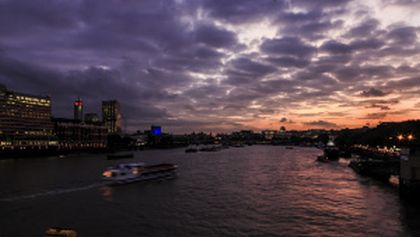
Dramatic sunset over the River Thames in London from Blackfriar’s Bridge. Time lapse shot over an hour. 16 seconds
Clip available from Shutterstock here
Clip available from Pond5 here
More about Blackfriars Bridge
The first fixed crossing at Blackfriars was a 995 feet (303 m) long toll bridge designed in an Italianate style by Robert Mylne and constructed with nine semi-elliptical arches of Portland stone. Beating designs by John Gwynn and George Dance, it took nine years to build, opening to the public in 1769. It was the third bridge across the Thames in the then built-up area of London, supplementing the ancient London Bridge, which dated from several centuries earlier, and Westminster Bridge. It was originally named “William Pitt Bridge” (after the Prime Minister William Pitt the Elder) as a dedication, but its informal name relating to the precinct within the City named after the Blackfriars Monastery, a Dominican priory which once stood nearby, was generally adopted. It was later made toll free.
The City of London Corporation was responsible for promoting it and the location between the other two bridges was chosen because it was realised that the disused wharfage of the lower River Fleet from the Thames to what became Ludgate Circus would allow access into the north bank without unduly disrupting the neighbourhood; hence its name of New Bridge Street. The Fleet can be seen discharging into the Thames at its north side. By taking an access road from its southern landing to a junction with the routes created to simplify passage between those bridges to its east and west to the south it would also add to those improvements. This created the junction at St George’s Circus between Westminster Bridge Road, Borough Road and the later named Blackfriars Road which crossed the largely open parish of Christchurch Surrey. The continuation to the south at the major junction at Elephant and Castle is therefore named London Road.
Although it was built of Portland stone the workmanship was very faulty. Between 1833 and 1840 extensive repairs were necessary, and a good deal of patching-up was done, until at last it was decided to build a new bridge on the same site and this coincided with the creation of the Thames Embankment’s junction with the new Queen Victoria Street required a major reconfiguration. This is the present bridge which in 1869 was opened by Queen Victoria.
The present bridge is 923 feet (281 m) long, consisting of five wrought iron arches built to a design by Joseph Cubitt. Cubitt also designed the adjacent rail bridge (now demolished) and it was a condition that the spans and piers of the two bridges be aligned. It was built by P.A. Thom & Co.[2] Like its predecessor it is owned and maintained by the Bridge House Estates, a charitable trust overseen by the City of London Corporation. Like London Bridge the full length and its southern end is within the City’s borders and not in the adjoining borough of Southwark. Due to the volume of traffic over the bridge, it was widened between 1907–10, from 70 feet (21 m) to its present 105 feet (32 m).
The bridge became internationally notorious in June 1982, when the body of Roberto Calvi, a former chairman of Italy’s largest private bank, was found hanging from one of its arches with five bricks and around $14,000 in three different currencies in his pockets. Calvi’s death was initially treated as suicide, but he was on the run from Italy accused of embezzlement and in 2002 forensic experts concluded that he had been murdered by the Mafia, to whom he was indebted. In 2005, five suspected members of the Mafia were tried in a Rome court for Calvi’s murder, but all were acquitted in June 2007 for lack of evidence.
